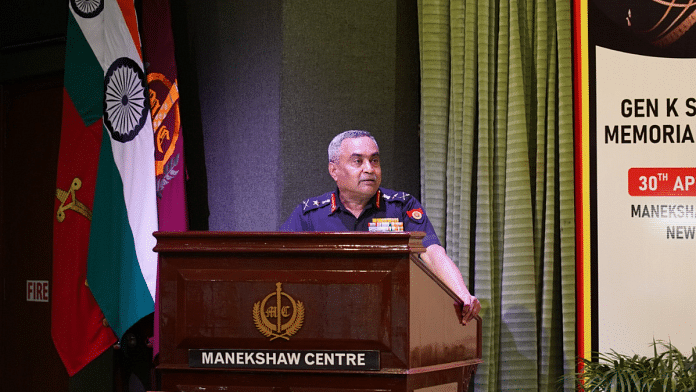New Delhi: Alluding to change in the character of warfare, Indian Army chief General Manoj Pande on Tuesday said that conventional force ratios — the measure of military strength and superiority in the past — stand largely blunted in today’s changed scenario.
Surveillance and precision are scoring over fire and manoeuvre, and the light and small are prevailing over the large and heavy, he said, adding that warfare had transcended into new domains such as space, cyber, electromagnetic spectrum and information.
“The imperative of technology infusion into warfighting systems and to keep pace with technological progression, remains enduring to this day. The impact of external dependency for critical components, supply chain disruptions and weaponisation of denial regimes came to the fore, during the pandemic and also from the lessons of the ongoing Russia-Ukraine conflict,” Gen Pande said, delivering the keynote address at the fourth General Sundarji Memorial Lecture.
India needs to recognise that no country will share the latest, advanced and critical technology with it, he said. Being import dependent for critical technologies, hence entails the risk of remaining one technological cycle behind, in niche areas. “The answer, therefore, lies in being self-reliant and achieving self-sufficiency in critical technologies through indigenous R&D.”
Today, he said, the people were witness to manifestations of Gen Sundarji’s forecasts.
“Disruptive and dual use technologies are no longer super-power centric. These are commercially available and non-state actors are gaining access to them, and employing them for military use towards gaining an asymmetric leverage in conflict.”
He said that when there is talk of digitisation of the battlefield, the forces are witnessing not just a manifold increase in the lethality and accuracy of kinetic instruments and increased proliferation of technology such as AI, quantum computing, robotics, 3D printing, and nanotechnology, but also disruptive and dual use technologies and their proliferation at an unprecedented scale.
This, he said, is transforming the character of modern wars.
“A suite of digital technologies encompassing electronic warfare, drones, precision attack systems, loiter munitions and others are challenging traditional force multipliers.”
He highlighted the Army’s focus areas for technology infusion and key systems that are being indigenously sourced. “Towards improving mobility and protection, procurements include Light Strike Vehicle, Light Specialist Vehicle and Bullet Proof Jackets,” he said.
Battlefield situational awareness was being increased through Border Surveillance System and nano drones, the Army chief said.
“For target acquisition and precision fires, we have swarm drones, loiter munitions and new artillery platforms such as 155mm MGS (Mounted Gun System), TGS (Towed Gun Systems), K9 Vajra, ATAGS (Advanced Towed Artillery Gun System),” he said.
“We are also deploying terrain specific electronic warfare systems, drones and anti-drone systems. Logistic capacities and efficiencies are being augmented by employing logistic drones. Induction of new weapon platforms for mechanised forces such as light tanks and future infantry combat vehicles and for aviation such as Light Utility Helicopters are in the pipeline.”
The Army is pursuing 45 niche technologies, which have been identified for military application, while another 120 indigenous projects are underway to develop and absorb these niche technologies.
Gen Pande added that the recent geo-political power plays have displayed that where national interests are concerned, countries will not hesitate to go to war. “Military strength and capabilities are, therefore, necessary to prevent war, to present a credible deterrence as also enabling a robust response to threats and winning wars, when required, across the entire spectrum of conflict,” he asserted.
(Edited by Tony Rai)






